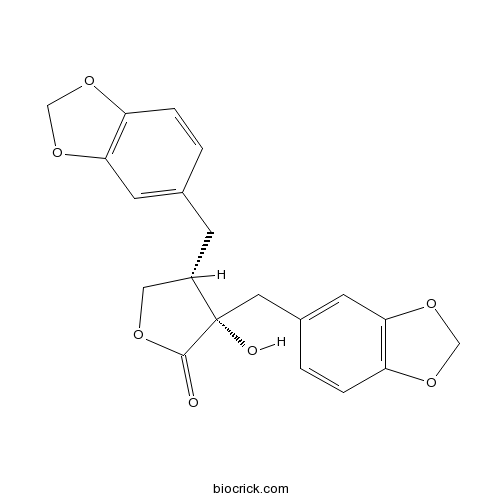MeridinolCAS# 120051-54-9 |

Quality Control & MSDS
3D structure
Package In Stock
Number of papers citing our products

| Cas No. | 120051-54-9 | SDF | Download SDF |
| PubChem ID | 11079164 | Appearance | Powder |
| Formula | C20H18O7 | M.Wt | 370.4 |
| Type of Compound | Lignans | Storage | Desiccate at -20°C |
| Solubility | Soluble in Chloroform,Dichloromethane,Ethyl Acetate,DMSO,Acetone,etc. | ||
| Chemical Name | (3S,4S)-3,4-bis(1,3-benzodioxol-5-ylmethyl)-3-hydroxyoxolan-2-one | ||
| SMILES | C1C(C(C(=O)O1)(CC2=CC3=C(C=C2)OCO3)O)CC4=CC5=C(C=C4)OCO5 | ||
| Standard InChIKey | OTWLSQPCSOEBAY-XOBRGWDASA-N | ||
| Standard InChI | InChI=1S/C20H18O7/c21-19-20(22,8-13-2-4-16-18(7-13)27-11-25-16)14(9-23-19)5-12-1-3-15-17(6-12)26-10-24-15/h1-4,6-7,14,22H,5,8-11H2/t14-,20-/m0/s1 | ||
| General tips | For obtaining a higher solubility , please warm the tube at 37 ℃ and shake it in the ultrasonic bath for a while.Stock solution can be stored below -20℃ for several months. We recommend that you prepare and use the solution on the same day. However, if the test schedule requires, the stock solutions can be prepared in advance, and the stock solution must be sealed and stored below -20℃. In general, the stock solution can be kept for several months. Before use, we recommend that you leave the vial at room temperature for at least an hour before opening it. |
||
| About Packaging | 1. The packaging of the product may be reversed during transportation, cause the high purity compounds to adhere to the neck or cap of the vial.Take the vail out of its packaging and shake gently until the compounds fall to the bottom of the vial. 2. For liquid products, please centrifuge at 500xg to gather the liquid to the bottom of the vial. 3. Try to avoid loss or contamination during the experiment. |
||
| Shipping Condition | Packaging according to customer requirements(5mg, 10mg, 20mg and more). Ship via FedEx, DHL, UPS, EMS or other couriers with RT, or blue ice upon request. | ||
| Description | 1. Meridinol has wide antimicrobial activity, includes against gram-positive and gram-negative bacteria and fungi. |
| Targets | Antifection |

Meridinol Dilution Calculator

Meridinol Molarity Calculator
| 1 mg | 5 mg | 10 mg | 20 mg | 25 mg | |
| 1 mM | 2.6998 mL | 13.4989 mL | 26.9978 mL | 53.9957 mL | 67.4946 mL |
| 5 mM | 0.54 mL | 2.6998 mL | 5.3996 mL | 10.7991 mL | 13.4989 mL |
| 10 mM | 0.27 mL | 1.3499 mL | 2.6998 mL | 5.3996 mL | 6.7495 mL |
| 50 mM | 0.054 mL | 0.27 mL | 0.54 mL | 1.0799 mL | 1.3499 mL |
| 100 mM | 0.027 mL | 0.135 mL | 0.27 mL | 0.54 mL | 0.6749 mL |
| * Note: If you are in the process of experiment, it's necessary to make the dilution ratios of the samples. The dilution data above is only for reference. Normally, it's can get a better solubility within lower of Concentrations. | |||||

Calcutta University

University of Minnesota

University of Maryland School of Medicine

University of Illinois at Chicago

The Ohio State University

University of Zurich

Harvard University

Colorado State University

Auburn University

Yale University

Worcester Polytechnic Institute

Washington State University

Stanford University

University of Leipzig

Universidade da Beira Interior

The Institute of Cancer Research

Heidelberg University

University of Amsterdam

University of Auckland

TsingHua University

The University of Michigan

Miami University

DRURY University

Jilin University

Fudan University

Wuhan University

Sun Yat-sen University

Universite de Paris

Deemed University

Auckland University

The University of Tokyo

Korea University
- Edgeworin
Catalog No.:BCN6561
CAS No.:120028-43-5
- VCH-916
Catalog No.:BCC2031
CAS No.:1200133-34-1
- Donepezil HCl
Catalog No.:BCC4569
CAS No.:120011-70-3
- Dichlorphenamide
Catalog No.:BCC3761
CAS No.:120-97-8
- 1,2-Benzenediol
Catalog No.:BCN6103
CAS No.:120-80-9
- N,N'-Bis(salicylidene)-1,3-propanediamine
Catalog No.:BCC9063
CAS No.:120-70-7
- 2'-Methylacetanilide
Catalog No.:BCC8581
CAS No.:120-66-1
- Isosafrole
Catalog No.:BCC3976
CAS No.:120-58-1
- Benzyl benzoate
Catalog No.:BCN8521
CAS No.:120-51-4
- Ethylparaben
Catalog No.:BCN6094
CAS No.:120-47-8
- Desoxyanisoin
Catalog No.:BCN2264
CAS No.:120-44-5
- 3-Amino-4-methoxybenzanilide
Catalog No.:BCC8613
CAS No.:120-35-4
- Shizukanolide F
Catalog No.:BCN6411
CAS No.:120061-96-3
- CRF (6-33)
Catalog No.:BCC5791
CAS No.:120066-38-8
- Fmoc-D-Arg(Mtr)-OH
Catalog No.:BCC3078
CAS No.:120075-24-3
- Flavanthrin
Catalog No.:BCN3687
CAS No.:120090-80-4
- IPI-145 (INK1197)
Catalog No.:BCC1104
CAS No.:1201438-56-3
- Crotaleschenine
Catalog No.:BCN2077
CAS No.:120154-95-2
- Vinflunine Tartrate
Catalog No.:BCC4602
CAS No.:1201898-17-0
- MLN9708
Catalog No.:BCC2091
CAS No.:1201902-80-8
- TCS 2210
Catalog No.:BCC7798
CAS No.:1201916-31-5
- Cynoglossamine
Catalog No.:BCN1970
CAS No.:120193-39-7
- 3,4-Dihydroxycinnamamide
Catalog No.:BCN6090
CAS No.:1202-41-1
- Clopidogrel
Catalog No.:BCC2497
CAS No.:120202-66-6
Chemical constituents from Amentotaxus yunnanensis and Torreyayunnanensis.[Pubmed:12880325]
J Nat Prod. 2003 Jul;66(7):1002-5.
In a chemical study of taxonomically related Taxaceae plants of Yunnan Province, China, seven compounds, including a new amentoflavone biflavonoid, 2,3-dihydro-7,7' '-dimethoxyamentoflavone (1), were isolated from Amentotaxus yunnanensis, and 12 isolates were obtained from Torreya yunnanensis. From the latter plant, a new abietane diterpene, torreyayunnin (7), is reported for the first time. The known isolates from A. yunnanensis have been identified as sequoiaflavone (3), sotetsuflavone (4), 7,7' '-dimethoxyamentoflavone (5), lutein, beta-sitosterol, and sequoyitol. Amentoflavone (2), sotetsuflavone (4), sciadopitysin (6), 12-hydroxydehydroabietinol, Meridinol, balanophonin, (+)-pinoresinol monomethyl ether, (+)-pinoresinol monomethyl ether glucoside, erythro-1-(4-hydroxy-3-methoxyphenyl)-2-[4-[2-formyl-(E)-vinyl]-2- methoxyphenoxy]propane-1,3-diol, threo-1-(4-hydroxy-3-methoxyphenyl)-2- [4-[2-formyl-(E)-vinyl]-2-methoxyphenoxy] propane-1,3-diol, and (E)-2-butenedioic acid were identified as known isolates from T. yunnanensis. The presence of the amentoflavone biflavonoids (1, 3-5) in A. yunnanensis supports its placement in the Taxaceae. The occurrence of the biflavonoid sotetsuflavone (4) in both A. yunnanensis and T. yunnanensis suggests that these two genera are closely related. The identification and structural elucidation of these isolates were based on spectral data analysis including 1D and 2D NMR.


